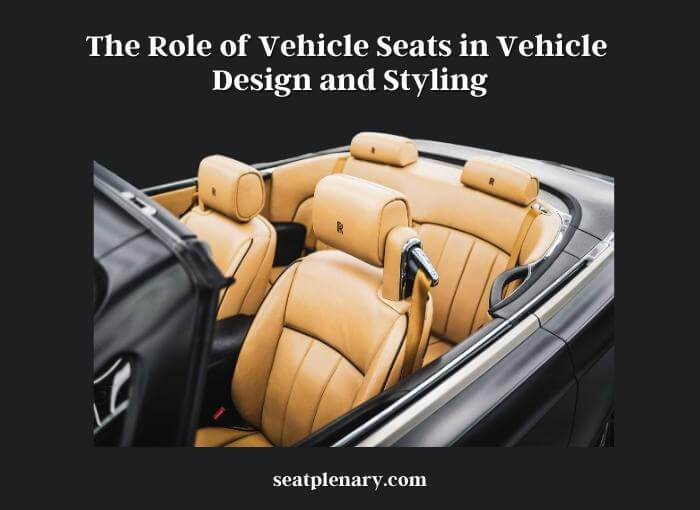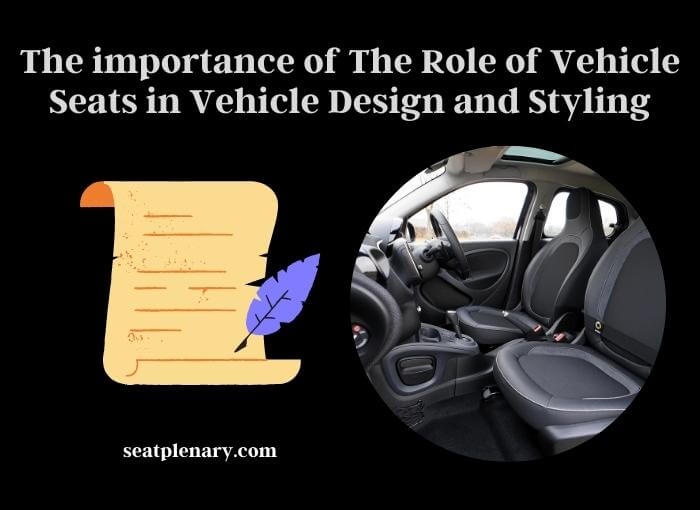As consumers, we often place a significant emphasis on the aesthetics and overall design of a car, from the sleek curves to the bold lines that create a stunning visual appeal. However, what many of us fail to realize is that vehicle seats play an equally important role in the overall vehicle design and styling. Vehicle seats are a critical component of the driving experience, playing a role in everything from comfort and ergonomics to safety and performance.

The importance of vehicle seats, we can gain a better appreciation for the complexity and intricacy involved in creating a car that not only looks good but also functions well and provides a comfortable and safe driving experience for all passengers.
Vehicle Seat Design
Vehicle seat design involves the creation of seats that provide comfort, support, and safety to occupants while fitting within the overall design and styling of the vehicle.
There are several factors that designers must consider when designing vehicle seats, including ergonomics, adjustability, materials, and safety.
Ergonomics
Ergonomics is an important consideration in vehicle seat design, as seats must be designed to accommodate passengers of different sizes and shapes. This includes the height, width, and depth of the seat, as well as the position and adjustability of the headrest, backrest, and lumbar support.
Adjustability
Adjustability is another key factor in vehicle seat design, as it allows drivers and passengers to customize the seat to their specific needs. Adjustability can include features such as seat height, seat angle, backrest angle, and lumbar support. Proper adjustability can improve comfort and reduce fatigue during long trips.
Materials
Materials used in vehicle seat design also play a significant role in the overall comfort and aesthetic of the seats. Common materials used in vehicle seats include leather, cloth, vinyl, and synthetic materials. The choice of material can impact the comfort, durability, and style of the seats.
Safety
Safety is a critical consideration in vehicle seat design. Seats must be designed to properly position and restrain occupants in the event of an accident. This includes the use of proper seat belts, airbags, and other safety features.
Vehicle seat design is a complex process that involves the consideration of multiple factors, including ergonomics, adjustability, materials, safety, and styling. Properly designed seats can provide comfort, support, and safety to occupants while enhancing the overall look and feel of the vehicle’s interior.
History of Vehicle Seats
Vehicle seats have been an important part of transportation for centuries. The earliest form of vehicle seating can be traced back to the horse-drawn carriages of the 18th and 19th centuries. These carriages were designed with bench-style seating, where passengers would sit next to each other on a long seat. The seats were often upholstered with plush materials such as velvet or leather to provide a comfortable ride.
With the invention of the automobile in the late 19th century, vehicle seats began to evolve. Early automobiles had simple bench seats that were often made of wood or metal. As the automobile industry grew and technology advanced, vehicle seats became more sophisticated. By the 1920s, car manufacturers began to incorporate adjustable seats, allowing drivers to adjust their seating position for comfort and better visibility.

In the 1930s, automotive seating began to incorporate springs and padding to provide a more comfortable ride. During this time, bucket seats were also introduced, which provided better support and comfort for drivers and passengers. In the 1950s, power seats were introduced, which allowed drivers to adjust their seat position with the push of a button.
In the 1960s, safety became a major concern in the automotive industry. As a result, seat belts were introduced, and vehicle seats were designed to better protect occupants in the event of a crash. During this time, headrests were also introduced to help prevent whiplash injuries.
In the 1970s, vehicle seats began to incorporate more advanced safety features, such as airbags and reinforced seat frames. In the 1980s, heated seats were introduced, which provided added comfort during cold weather. In the 1990s, leather seating became a popular option in luxury vehicles, providing a high-end look and feel.
Today, vehicle seats continue to evolve with the latest technology and materials. Many vehicles now feature ergonomic seats that are designed to provide better support and reduce fatigue during long drives. Some vehicles also feature massage seats, which provide added comfort and relaxation. As safety continues to be a top priority in the automotive industry, vehicle seats are being designed with advanced safety features such as seatbelt pre-tensioners and side airbags.
Comfort and Ergonomics
When it comes to the design and styling of vehicle seats, comfort, and ergonomics are perhaps the most critical considerations. After all, a car with uncomfortable seats can make even the shortest of drives an unpleasant experience. In addition to comfort, the design must account for proper support and posture, which is where features like lumbar adjustments and cushion firmness come into play. One notable option that many drivers appreciate are highback bucket seats benefits, which include enhanced lateral support and a more immersive driving experience. These seats help reduce fatigue on longer journeys by providing better alignment for the spine and shoulders.
Car manufacturers understand this, which is why they invest a significant amount of time and resources into designing seats that provide optimal comfort and ergonomics for the driver and passengers.
Seat design is a crucial aspect of achieving a comfortable and ergonomic driving experience. Factors such as seat angle, lumbar support, and padding thickness all play a role in creating a comfortable seating position. A seat that is too flat or angled incorrectly can cause discomfort and even pain for the driver or passengers, while a well-designed seat that provides ample lumbar support can help prevent lower back pain.
The materials used for seats also have an impact on comfort. For example, leather seats may be more comfortable and breathable than vinyl or cloth seats, while Alcantara seats provide a luxurious feel that many drivers and passengers appreciate. Additionally, car manufacturers may use specialized materials such as memory foam or gel to enhance comfort and reduce pressure points.
Adjustability features are also crucial for achieving optimal comfort and ergonomics. Seat height, tilt, and headrest position can all contribute to the overall comfort of the driver and passengers. For example, a taller driver may require a higher seat position to achieve optimal visibility, while a shorter driver may benefit from a seat that can be adjusted to a lower position. A headrest that is positioned correctly can help prevent neck injuries in the event of an accident.
Designing vehicle seats that prioritize comfort and ergonomics are essential for creating a car that drivers and passengers will enjoy using for extended periods. Car manufacturers continually innovating new seat designs and materials to enhance the driving experience. As consumers, it’s essential to prioritize comfort and ergonomics when selecting a car, as it can impact our overall enjoyment and even our health in the long run.
Aesthetics and Brand Identity
In addition to providing optimal comfort and ergonomics, vehicle seats also play a vital role in creating a unique and recognizable brand identity. Car manufacturers use seat design to differentiate their brands and appeal to different customer segments.
Luxury car manufacturers, for example, may use high-end materials such as leather or Alcantara to create a more luxurious feel. This helps to appeal to customers who prioritize style and luxury in their vehicle purchases. On the other hand, sporty car manufacturers may opt for racing-style seats with more pronounced bolsters and aggressive styling to appeal to driving enthusiasts.
Seat materials, colors, and textures can also impact the overall aesthetic of the vehicle, contributing to the overall design and styling. Car manufacturers may use unique seat colors and stitching patterns to create a distinctive look that sets their cars apart from the competition.
For example, a car with red leather seats may be seen as more sporty and aggressive than a car with black leather seats. Alternatively, a car with light-colored fabric seats may be perceived as more eco-friendly and modern.
Vehicle seats are an integral component of a car’s design language and can help create a unique and recognizable brand identity. By using seat design to appeal to different customer segments, car manufacturers can create a distinct look and feel for their brand, helping to differentiate themselves from their competitors and attract loyal customers.
As consumers, it’s essential to consider a car’s seat design and aesthetics when selecting a vehicle, as it can impact our overall satisfaction with the car and even our sense of personal style.
The importance of The Role of Vehicle Seats in Vehicle Design and Styling
The role of vehicle seats in vehicle design and styling is crucial, as they not only provide comfort and support to passengers but also play a significant role in the overall aesthetic of the vehicle. Vehicle seats are one of the most visible and frequently used components of the vehicle’s interior, and they can greatly influence the perception of the vehicle’s quality and value.

The design of vehicle seats can greatly impact the functionality and usability of the vehicle. The positioning of the seat, its adjustability, and the level of support it provides can all affect the driving experience and the overall satisfaction of the driver and passengers. Therefore, designers must consider the ergonomics of the seats and their ability to accommodate passengers of different sizes and shapes.
Vehicle seats can also contribute to the vehicle’s style and design. The material, color, and stitching of the seats can greatly enhance the interior of the vehicle and add to its overall aesthetic appeal. For example, leather seats are often associated with luxury and high-end vehicles, while cloth seats may be associated with more practical or budget-friendly options.
Vehicle manufacturers also use seats as a way to differentiate their vehicles from competitors. Unique seat designs, patterns, and materials can create a signature look for a particular brand or model of vehicle. This can help to attract buyers and increase the perceived value of the vehicle.
The role of vehicle seats in vehicle design and styling is multifaceted. They must provide comfort and support, be functional and practical, and contribute to the overall aesthetic and value of the vehicle. As the automotive industry continues to evolve, vehicle seats will undoubtedly continue to play a critical role in vehicle design and styling.
Safety and Performance
Providing comfort and contributing to a car’s overall design and styling, vehicle seats also play a crucial role in safety and performance. Proper seat design and placement can help reduce the risk of injury in the event of an accident, while racing-style seats can improve performance by providing better support during aggressive driving maneuvers.
Seat belts, which are integrated into the seat design, are perhaps the most critical safety feature of a car’s seats. Proper seat belt placement is essential for protecting the driver and passengers in the event of a crash. Car manufacturers invest significant resources into designing seat belts that provide optimal safety, using features such as pre-tensioners that tighten the belt in the event of a collision.
Proper seat placement is also crucial for safety. The driver’s seat should be positioned to provide optimal visibility and reach the controls, while the passenger seats should be designed to reduce the risk of injury during a crash. For example, the seat backs of rear seats may be designed to absorb impact energy, helping to reduce the risk of injury to passengers in the event of a rear-end collision.
In addition to safety, vehicle seats can also impact performance. Racing-style seats with pronounced bolsters and aggressive styling can provide better support during aggressive driving maneuvers, helping to keep the driver in place and reduce fatigue. Proper seat angle and placement can also impact performance, with a well-designed seat contributing to better control and handling.
Vehicle seats play a crucial role in safety and performance. Car manufacturers understand this and invest significant resources into designing seats that provide optimal safety and support for drivers and passengers. One example of this is the development of gamechanging racing seat technology, which has revolutionized the way racing drivers experience comfort and stability during high-speed races. These specially designed seats are engineered to keep drivers secure and firmly in place, regardless of the intense G-forces experienced on the track. The innovation and precision that go into creating these seats not only enhance driver performance but also set new standards for safety in the automotive industry.
As consumers, it’s important to prioritize safety and performance when selecting a car, considering factors such as seat placement, design, and features such as seat belts to ensure we’re making a safe and informed purchase decision.
Benefits of The Role of Vehicle Seats in Vehicle Design and Styling
The role of vehicle seats in vehicle design and styling offers several benefits, including:
Comfort
Properly designed vehicle seats provide the necessary support and cushioning for passengers to feel comfortable during long trips. Comfortable seats can reduce fatigue, promote relaxation, and enhance the overall driving experience. For drivers who experience back pain or discomfort, finding relief with bucket seats can make a significant difference in their overall well-being. The contoured design of bucket seats provides additional support for the lower back, easing tension and promoting proper posture. This can ultimately reduce strain and discomfort during long drives, allowing passengers to arrive at their destination feeling refreshed and relaxed.
Safety
Vehicle seats are an integral part of a vehicle’s safety system. Properly designed seats can help to reduce injuries in the event of an accident by properly positioning and restraining occupants.
Aesthetics
Vehicle seats contribute to the overall look and feel of the vehicle’s interior. Unique seat designs and materials can create a signature look for a particular brand or model of vehicle, making it more recognizable and attractive to buyers.
Brand Differentiation
Vehicle seats can help to differentiate one brand from another. Unique seat designs, patterns, and materials can create a distinctive look for a brand or model, helping to attract buyers and increase the perceived value of the vehicle.
Customization
Vehicle seats can be customized to meet the specific needs of individual buyers. Customized seats can provide added comfort and support, as well as reflect the personal style and preferences of the owner.
Innovation
Vehicle seats are an area of ongoing innovation, with new materials, designs, and features continually being introduced. This innovation can improve the comfort, safety, and functionality of vehicle seats, making the driving experience more enjoyable and convenient.
The role of vehicle seats in vehicle design and styling offers a range of benefits, including comfort, safety, aesthetics, brand differentiation, customization, and innovation. As such, the design and functionality of vehicle seats are crucial considerations for automakers in creating a successful and appealing vehicle.
How Can Bench Seats Enhance the Stylish Design of a Vehicle?
When it comes to enhancing the stylish design of a vehicle, comfortable bench seat options can make a significant impact. The sleek and modern look of bench seats can add a touch of sophistication to the interior of a vehicle, elevating its overall aesthetic appeal.
How Can Vehicle Seat Accessories Enhance the Overall Design and Styling of a Vehicle?
Vehicle seat covers can instantly elevate the look of your car’s interior. Whether you choose sleek, leather covers or fun, patterned ones, they can add a pop of color and style to the otherwise mundane seating. They provide protection from spills and wear, keeping your seats looking fresh and new.
Can NRG racing seats be used for both performance and style in vehicles?
Yes, NRG racing seats have gained nrg racing seat approval status for both performance and style in vehicles. These seats are designed to provide optimal support and comfort during high-speed driving while also adding a sleek, sporty look to the interior of the vehicle.
Conclusion
Vehicle seats are a critical component of a car’s design and functionality, impacting comfort, ergonomics, aesthetics, safety, and performance. Car manufacturers invest significant resources into designing seats that provide optimal support, safety, and style, contributing to a car’s overall design language and brand identity.
From luxury leather seats to racing-style bucket seats, car manufacturers use seat design to appeal to different customer segments and create a unique brand identity. Seat materials, colors, and textures all impact a car’s aesthetic, contributing to its overall design and styling.
In terms of safety, proper seat design and placement can reduce the risk of injury in the event of an accident. Car manufacturers invest in designing seat belts that provide optimal safety, using features such as pre-tensioners that tighten the belt in the event of a collision. Proper seat placement and design can also impact performance, with racing-style seats providing better support and control during aggressive driving maneuvers.
It’s essential to consider a car’s seat design and functionality when making a purchase decision. Whether we prioritize comfort, style, safety, or performance, seat design is a crucial factor to consider.
Relevant Resources:
